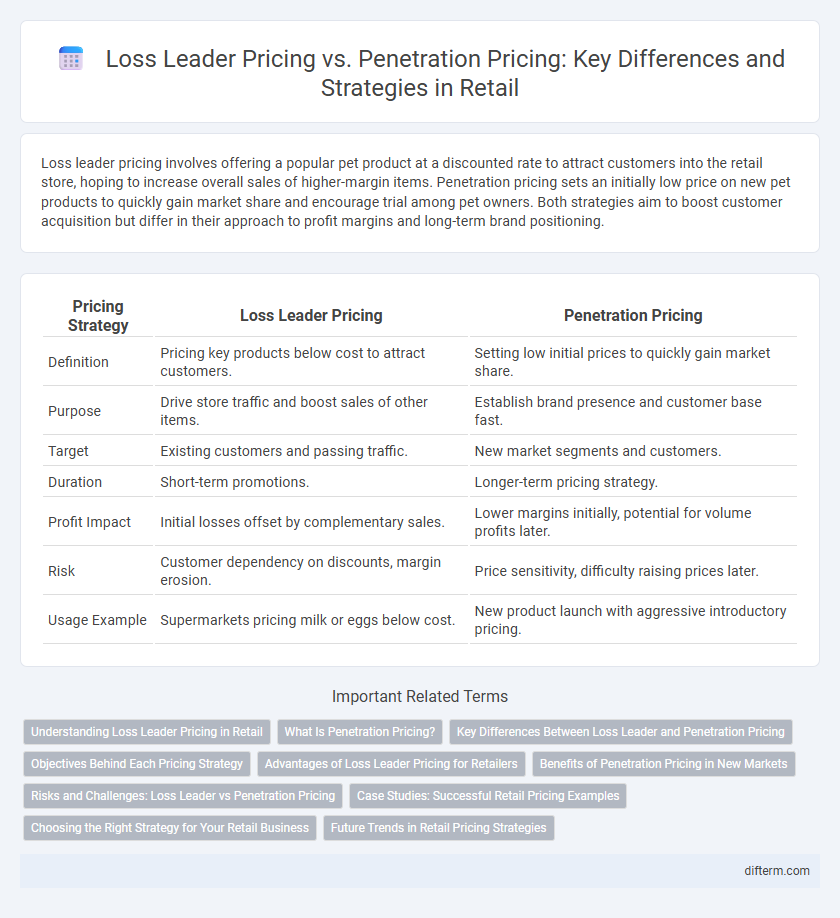Loss leader pricing involves offering a popular pet product at a discounted rate to attract customers into the retail store, hoping to increase overall sales of higher-margin items. Penetration pricing sets an initially low price on new pet products to quickly gain market share and encourage trial among pet owners. Both strategies aim to boost customer acquisition but differ in their approach to profit margins and long-term brand positioning.
Table of Comparison
| Pricing Strategy | Loss Leader Pricing | Penetration Pricing |
|---|---|---|
| Definition | Pricing key products below cost to attract customers. | Setting low initial prices to quickly gain market share. |
| Purpose | Drive store traffic and boost sales of other items. | Establish brand presence and customer base fast. |
| Target | Existing customers and passing traffic. | New market segments and customers. |
| Duration | Short-term promotions. | Longer-term pricing strategy. |
| Profit Impact | Initial losses offset by complementary sales. | Lower margins initially, potential for volume profits later. |
| Risk | Customer dependency on discounts, margin erosion. | Price sensitivity, difficulty raising prices later. |
| Usage Example | Supermarkets pricing milk or eggs below cost. | New product launch with aggressive introductory pricing. |
Understanding Loss Leader Pricing in Retail
Loss leader pricing in retail involves selling products at a price below cost to attract customers and increase foot traffic, thereby boosting sales of higher-margin items. Retailers strategically select loss leaders based on high-demand or essential products to maximize store visits and cross-selling opportunities. This pricing tactic leverages consumer behavior patterns to enhance overall profitability despite initial losses on certain items.
What Is Penetration Pricing?
Penetration pricing is a retail strategy where products are introduced at a significantly low price to quickly attract customers and gain market share. This approach aims to encourage trial purchases, build brand loyalty, and deter competitors by establishing a broad customer base early. Retailers using penetration pricing often increase prices gradually once market presence and consumer trust are secured.
Key Differences Between Loss Leader and Penetration Pricing
Loss leader pricing involves selling select products below cost to attract customers and increase overall store traffic, while penetration pricing sets a low initial price across a product line to quickly gain market share. Loss leader strategies focus on driving sales for complementary items, relying on increased volumes to offset losses, whereas penetration pricing aims to establish a competitive position and deter entrants. Retailers using loss leader pricing often target existing customers to boost incremental purchases, while penetration pricing targets new customers with the expectation of long-term profitability through price adjustments.
Objectives Behind Each Pricing Strategy
Loss leader pricing aims to attract customers by offering products below cost to increase store traffic and promote the sale of higher-margin items. Penetration pricing focuses on setting low initial prices to rapidly gain market share and establish brand presence in competitive retail sectors. Both strategies drive customer acquisition but differ in whether short-term profit sacrifice targets overall sales volume growth or market entry dominance.
Advantages of Loss Leader Pricing for Retailers
Loss leader pricing enables retailers to attract a high volume of customers by offering popular products at below cost, increasing overall foot traffic in stores. This strategy boosts cross-selling opportunities, encouraging consumers to purchase additional full-priced items, thereby improving profit margins. Retailers gain competitive advantage and brand loyalty through enhanced customer perception of value and frequent store visits.
Benefits of Penetration Pricing in New Markets
Penetration pricing rapidly attracts a large customer base by offering products at a low initial price, boosting market share and brand recognition in new markets. This strategy discourages competitors by establishing strong market presence and creating customer loyalty through perceived value and affordability. Sustained sales volume at competitive prices leads to economies of scale, reducing costs and increasing profitability as the market matures.
Risks and Challenges: Loss Leader vs Penetration Pricing
Loss leader pricing carries the risk of eroding profit margins as products are sold below cost, potentially attracting bargain hunters rather than loyal customers. Penetration pricing challenges include the difficulty of raising prices later without alienating customers and the potential for triggering price wars with competitors. Both strategies require careful financial analysis and market research to avoid long-term profitability issues and brand devaluation.
Case Studies: Successful Retail Pricing Examples
Loss leader pricing proved highly effective in Walmart's strategy by attracting customers with deeply discounted staple items, boosting overall store traffic and increasing sales of higher-margin products. Penetration pricing enabled Amazon Fresh to rapidly gain market share by offering groceries at lower prices than competitors, fostering customer loyalty and accelerating growth in new regions. These case studies showcase how targeted pricing strategies can drive customer acquisition and long-term profitability in competitive retail markets.
Choosing the Right Strategy for Your Retail Business
Loss leader pricing involves offering select products at a price below cost to attract customers and increase store traffic, while penetration pricing sets low prices across the board to quickly gain market share. Choosing the right strategy depends on factors such as target customer behavior, competitive landscape, and long-term profitability goals. Retailers should analyze product margins, brand positioning, and customer acquisition costs to determine whether a focused loss leader approach or broad penetration pricing aligns best with their business objectives.
Future Trends in Retail Pricing Strategies
Retail pricing strategies are evolving with an increased emphasis on data-driven approaches, where loss leader pricing remains effective for driving foot traffic but faces challenges due to rising e-commerce competition. Penetration pricing is gaining traction in digital retail by rapidly capturing market share through ultra-competitive introductory prices, often supported by AI-powered dynamic pricing tools. Future trends indicate a blend of personalized pricing algorithms and sustainability considerations that optimize customer acquisition while maintaining long-term profitability.
Loss Leader Pricing vs Penetration Pricing Infographic

 difterm.com
difterm.com